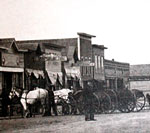Rural Minnesota Continues To Lose Population
By Mark Steil
December 13, 2000
The 2000 census will likely show continued population losses in the state's most rural counties. In western Minnesota, some counties have lost 10 percent of their residents over the last decade. Lac Qui Parle County shows one of the biggest losses as its population ages.
WALKING ON THE MAIN STREET OF MARIETTA
with Mayor Don Ransom, it's easy to feel there are ghosts everywhere.
"The old bank building is gone, the restaurant and the locker plant. Over on the east side there was the beer joint, which is gone. Then you had the cafe and it used to be a grocery store, too. Then there was a barbershop. At one time it was a hardware store," Ransom said.
The businesses have disappeared and so have most of the buildings which housed them - torn down as fire traps.
Ransom says the main cause of his town's decline is the trend toward bigger farms. Fewer families are working more acres, with less to spend on Main Street in Marietta. Ransom has lived all his 73 years in this town near the South Dakota border. He's not happy with the changes, but concedes there isn't much that can be done about it.
Census figures show Marietta's population has fallen 15 percent in the last 10 years. Fewer than 200 people live here. The downtown business area is basically a bank, post office and hardware store, and a grain elevator is still operating. It's happening all over Lac Qui Parle County, where the population peaked in the 1920s at more than 15,000. Now it's about half that. Mayor Ransom is not looking for big changes in Marietta anytime soon.
"I would doubt any business development will ever move in, unless somebody won the lottery," Ransom laughs.
On the northern edge of Lac Qui Parle County, the town of Louisburg is also facing a slow population ebb. Louisburg is even smaller than Marietta, with only about 40 people. The only business in town is a grain elevator. The town is so small that Mayor Spencer Jensen has committed every nook and cranny of it to memory. When asked how many houses Louisburg has, he leans back, half closes his eyes, and counts them all.
Jensen says most of the houses sold in Louisburg are bought by hunters from the Twin Cities, who use them as base camps to hunt geese at nearby Lac Qui Parle Wildlife Area.
"The way the declining population is going here I'm guessing, in a few years, it's probably going to be a hunter's city," Jensen said.
The towns of Marietta and Louisburg are symbols of what's happening all over Lac Qui Parle County, western Minnesota and even the Great Plains. It's a decline as slow and gradual as the graceful, but certain, change the weather brings to the old farm buildings dotting the landscape. State Demographer Tom Gillaspy says the best news is that the population losses in most counties were not as bad during the 1990s as in the '80s. But he expects the overall decline to continue.
"When you have a situation where you have a relatively old population, and you have actually more people dying than are being born, it's really hard to turn that around," Gillaspy said.
But the residents of Lac Qui Parle County are not without hope. In the county seat of Madison - population 2,200 - a new business has come to town.
Cross USA has placed a "technology center" in Madison. The company has similar facilities in Sebeka, Minn. and Watford City, N.D. Using high-speed data lines, Cross USA programmers help corporate clients keep their in-house computer networks up to date. The company only has a half-dozen employees in Madison now, but that number is expected to grow.
Elton Fordyce moved from the Twin Cities to Madison to work for Cross USA. He says his co-workers come from a variety of places: Alabama, Detroit, the Twin Cities.
"They're looking for a nice rural area to live in. Quiet, peaceful, and a place where they can go out enjoy themselves but also do the kind of work they like doing," Fordyce said.
Born and raised in Milbank, S.D., Fordyce wanted to get back to small-town life after 20 years in the Twin Cities. He walks to work. He figures the house he bought in Madison for about $50,000 would cost $200,000 in the metro area. That's a selling point for Lac Qui Parle and other Minnesota counties looking for new jobs and people. But so far the smattering of high-tech jobs in rural areas has not been enough to reverse the long term population decline.
By Mark Steil
December 13, 2000
|
|
RealAudio |
The 2000 census will likely show continued population losses in the state's most rural counties. In western Minnesota, some counties have lost 10 percent of their residents over the last decade. Lac Qui Parle County shows one of the biggest losses as its population ages.
| |
|
|
|
||
"The old bank building is gone, the restaurant and the locker plant. Over on the east side there was the beer joint, which is gone. Then you had the cafe and it used to be a grocery store, too. Then there was a barbershop. At one time it was a hardware store," Ransom said.
The businesses have disappeared and so have most of the buildings which housed them - torn down as fire traps.
Ransom says the main cause of his town's decline is the trend toward bigger farms. Fewer families are working more acres, with less to spend on Main Street in Marietta. Ransom has lived all his 73 years in this town near the South Dakota border. He's not happy with the changes, but concedes there isn't much that can be done about it.
Census figures show Marietta's population has fallen 15 percent in the last 10 years. Fewer than 200 people live here. The downtown business area is basically a bank, post office and hardware store, and a grain elevator is still operating. It's happening all over Lac Qui Parle County, where the population peaked in the 1920s at more than 15,000. Now it's about half that. Mayor Ransom is not looking for big changes in Marietta anytime soon.
"I would doubt any business development will ever move in, unless somebody won the lottery," Ransom laughs.
On the northern edge of Lac Qui Parle County, the town of Louisburg is also facing a slow population ebb. Louisburg is even smaller than Marietta, with only about 40 people. The only business in town is a grain elevator. The town is so small that Mayor Spencer Jensen has committed every nook and cranny of it to memory. When asked how many houses Louisburg has, he leans back, half closes his eyes, and counts them all.
Jensen says most of the houses sold in Louisburg are bought by hunters from the Twin Cities, who use them as base camps to hunt geese at nearby Lac Qui Parle Wildlife Area.
"The way the declining population is going here I'm guessing, in a few years, it's probably going to be a hunter's city," Jensen said.
| |
|
|
|
||
"When you have a situation where you have a relatively old population, and you have actually more people dying than are being born, it's really hard to turn that around," Gillaspy said.
But the residents of Lac Qui Parle County are not without hope. In the county seat of Madison - population 2,200 - a new business has come to town.
Cross USA has placed a "technology center" in Madison. The company has similar facilities in Sebeka, Minn. and Watford City, N.D. Using high-speed data lines, Cross USA programmers help corporate clients keep their in-house computer networks up to date. The company only has a half-dozen employees in Madison now, but that number is expected to grow.
Elton Fordyce moved from the Twin Cities to Madison to work for Cross USA. He says his co-workers come from a variety of places: Alabama, Detroit, the Twin Cities.
"They're looking for a nice rural area to live in. Quiet, peaceful, and a place where they can go out enjoy themselves but also do the kind of work they like doing," Fordyce said.
Born and raised in Milbank, S.D., Fordyce wanted to get back to small-town life after 20 years in the Twin Cities. He walks to work. He figures the house he bought in Madison for about $50,000 would cost $200,000 in the metro area. That's a selling point for Lac Qui Parle and other Minnesota counties looking for new jobs and people. But so far the smattering of high-tech jobs in rural areas has not been enough to reverse the long term population decline.


